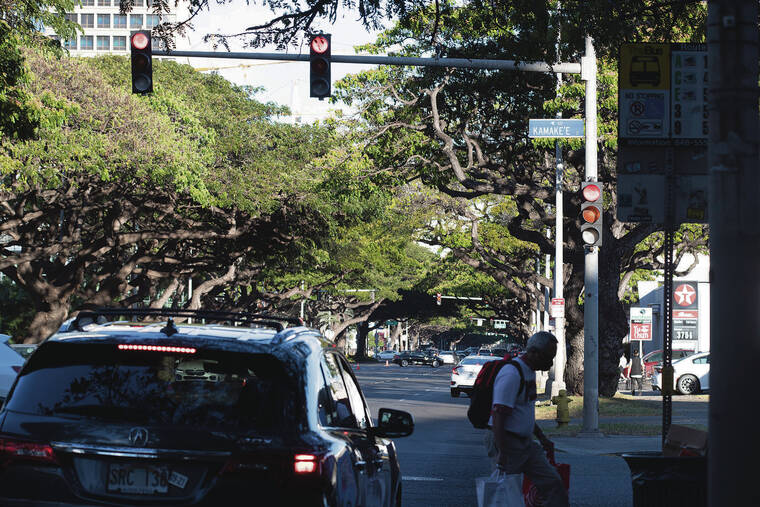The state Department of Transportation has opted to commence its two-year red-light camera pilot program at the end of the year rather than the end of this summer.
The time frame for the pilot program shifted due to the availability of funds, according to DOT spokeswoman Shelly Kunishige.
“The additional funding authorized by the Legislature in the 2020 session was made available in August, which has driven the decision to start the pilot at the end of the year instead of the end of the summer,” she said in an email.
The later start also gives the DOT time to perform engineering studies and to launch a public education campaign, she said. The campaign must begin 60 days before the system begins working and will include details on the sites, which haven’t been finalized.
In 2002 the public railed against a photo enforcement system run by a private contractor to ticket speeding drivers on Oahu that became known as “van cams.” Lawmakers had passed a law in 1998 authorizing the system but then repealed it due to the outcry.
Legislators moved forward in 2017 with a separate plan for cameras to photograph the license plates of vehicles that run red lights, but implementation was delayed and many of the details have yet to be finalized.
The DOT has identified 14 intersections in urban Honolulu where the red-light cameras might be installed, and will narrow the list to 10 after an engineering review. Possible sites run from the King and Middle streets intersection to McCully and Algaroba streets.
The public will have time to get used to the new enforcement system. Once the program is operational and signs alerting the public to the presence of cameras are in place, the system will issue mere warnings for a month before beginning to mail out citations.
At a DOT public hearing June 17, testifiers expressed a multitude of concerns about the proposed administrative rules establishing the pilot program. Some questioned whether officials fully examined the reasons van cams flopped and whether the state would once again find itself in the position of having to pay a contractor for another failed program.
“The main difference between the previous photo enforcement and this one is that the vendor will not receive a portion of each citation issued, and they will not have access to change or adjust the timing of the lights,” said Lee Nagano, DOT motor vehicle safety administrator, at the hearing.
Since it is a two-year pilot program, she said, all the data will be reviewed at the end of the trial run, and “we’ll make any necessary changes before the program is made permanent.”
Others commented that it’s unfair to cite vehicle owners and not drivers for running a red light.
Kunishige told the Honolulu Star-Advertiser that a legislative task force looked at the issue and, due to privacy issues, decided that only license plates would be photographed and not the drivers.
Addressing concerns it would be difficult for registered vehicle owners to come up with proof someone else was at the wheel at the time of the offense, she said it’s the responsibility of vehicle owners to make sure whomever they lend their car to is aware of traffic laws and intends to follow them.
During the June hearing, Nagano noted that citations will not be issued during the pilot program for turning right on red and that there will be opportunities for motorists to appeal, such as in situations in which their vehicle was stolen, the traffic light wasn’t working properly or there was an emergency and they were directed by law enforcement to proceed through the red light.
PROPOSED LOCATIONS
14 intersections eyed for the red-light traffic camera program, with 10 to be chosen:
>> King and Middle streets
>> Likelike Highway and School Street
>> King and Kohou streets
>> Vineyard Boulevard and Palama Street
>> Vineyard Boulevard and Liliha Street
>> King and River streets
>> North King and Beretania streets
>> Vineyard Boulevard and Nuuanu Avenue
>> Pali Highway and Vineyard Boulevard
>> Pali Highway and School Street
>> King Street and Ward Avenue
>> Kapiolani Boulevard and Kamakee Street
>> Beretania and Piikoi streets
>> McCully and Algaroba streets




